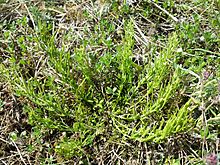Dolliner flax leaf
| Dolliner flax leaf | ||||||||||||
|---|---|---|---|---|---|---|---|---|---|---|---|---|

Dolliner flax leaf ( Thesium dollineri ) |
||||||||||||
| Systematics | ||||||||||||
|
||||||||||||
| Scientific name | ||||||||||||
| Thesium dollineri | ||||||||||||
| Murb. |
The Dolliner linseed leaf ( Thesium dollineri ), also called low linseed leaf , is a species of the sandalwood family (Santalaceae). This semi-parasite is mainly found in the Balkan Peninsula and in Eastern Europe.
description

Vegetative characteristics
The Dolliner linseed leaf is an annual , sometimes perennial herbaceous plant that usually reaches heights of 6 to 15 centimeters. Two different forms can occur at the same sites: Specimens that already bloom in autumn develop long, blooming side branches (coflorescences) along the main stem. Specimens that overwinter, on the other hand, sprout numerous unbranched flowering shoots from the hypocotyl . The latter form was described as a separate species “ Th. Simplex ” and is sometimes referred to as a subspecies “ Thesium dollineri subsp. simplex ”. The alternately arranged leaves are simple, undivided, narrow-linear, entire and have a leaf vein .
Generative characteristics
The blooming time of the Dolliner linseed leaves in Central Europe from April to September. The inflorescence is a raceme . Of 1 to 3 millimeters long flower stem has at the upper end, just below the flower, three bracts : a cover sheet whose stem is grown together with the flower stem, and two smaller side prophylls . While the blade of the wrapper is the same length to four times as long as the fruit, the bracts are about the length of the fruit.
The flowers have an overgrown, radially symmetrical perigon , which has five, sometimes only four, tips that are white on the inside and green on the outside. At the time of fruiting, the perigone curls up to the bottom. The flower has four or five stamens and under constant ovary with a stylus on. The network-nerved fruits are at least as long as the stalk and three to four times as long as the rolled up perigone.
ecology
The Dolliner flax leaf is a therophyte , partially hemicryptophyte . The Dolliner linseed leaf is a semi-parasite (hemiparasite): the roots of the linseed leaf tap into the roots of host plants by means of haustoria (suction organs for absorbing nutrients) and deprive them of nutrients .
Occurrence and endangerment
The Dolliner-Leinblatt has its main distribution area on the Balkan Peninsula and from Central Europe to Eastern Europe . In the German-speaking area, this species is indigenous only in Austria .
In Austria, the Dolliner flax leaf occurs rarely on dry meadows, dry grass and arable slopes in the colline altitude . The Austrian occurrences are limited to the Pannonian area of the federal states of Vienna , Lower Austria and Burgenland . The Dolliner flax leaf is considered endangered.
Systematics
The first description of Thesium dollineri was in 1891 by Svante Samuel Murbeck . The specific epithet dollineri honors the Austrian botanist Georg Dolliner (1794–1872).
Three subspecies have been described:
- Thesium dollineri Murb. subsp. dollineri : It occurs in Austria, Hungary, Croatia, the Czech Republic, Slovakia, Serbia, Romania and Bulgaria.
- Thesium dollineri subsp. moesiacum (Velen.) Stoj. & Stef. : It occurs in Bulgaria, Ukraine and Russia.
- Thesium dollineri subsp. simplex (Velen.) Stoj. & Stef. : It occurs in Austria, Hungary, Croatia, the Czech Republic, Serbia, Bosnia-Herzegovina, Bulgaria, Slovakia, Romania, Ukraine and Moldova.
Individual evidence
- ↑ a b c d e f Manfred A. Fischer, Karl Oswald, Wolfgang Adler: Excursion flora for Austria, Liechtenstein and South Tyrol . 3rd, improved edition. Province of Upper Austria, Biology Center of the Upper Austrian State Museums, Linz 2008, ISBN 978-3-85474-187-9 , p. 387 .
- ↑ a b c d P. Uotila, 2011: Santalaceae. In: Euro + Med Plantbase - the information resource for Euro-Mediterranean plant diversity : data sheet Thesium dollineri




